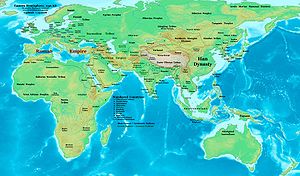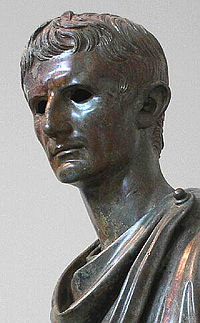
1st century
Background Information
SOS Children produced this website for schools as well as this video website about Africa. Before you decide about sponsoring a child, why not learn about different sponsorship charities first?
| Millennium: | 1st millennium |
|---|---|
| Centuries: |
|
| Decades: | 0s 10s 20s 30s 40s 50s 60s 70s 80s 90s |
| Categories: | Births – Deaths Establishments – Disestablishments |
The 1st century was the century that lasted from 1 to 100 according the Julian calendar. It is considered part of the Classical era, epoch, or historical period.
During this period Europe, North Africa and the Near East fell under increasing domination by the Roman Empire, which continued expanding, most notably conquering Britain under the emperor Claudius ( 43). The reforms introduced by Augustus during his long reign stabilized the empire after the turmoil of the previous century's civil wars. Later in the century the Julio-Claudian dynasty, which had been founded by Augustus came to an end with the death of Nero in 68. There followed the famous Year of Four Emperors, a brief period of civil war and instability, which was finally brought to an end by Vespasian, 9th Roman emperor, and founder of the Flavian dynasty.
China continued to be dominated by the Han Dynasty, despite a 14-year interruption by the Xin dynasty under Wang Mang. Han rule was restored in 23; Wang Mang's rule represents the watershed between the Western/Former Han and the Eastern/Later Han. The capital was also moved from Chang'an to Luoyang.
Regional Events and Politics
- Northern Europe:
- Western Europe: Controlled by Rome.
- Central Europe:
- Eastern Europe:
- Southern Europe: Controlled by Rome.
- North Africa: Controlled by Rome.
- West Africa: Numerous tribal governments.
- Central Africa: Bantu tribes, collapsing Nok civilization.
- East Africa: Meroe, Blemmyes, Axum Empire.
- Southern Africa: Bantu tribes, Khoisan.
- Western Asia: Rome, Parthian empires, as well as many smaller tribes.
- Central Asia: Sarmatian tribes.
- South-central Asia: Kushan empire, Western Satraps, Satavahana, Tibetans.
- Southeast Asia: City states, Khmer, Mon kingdoms, Funan.
- East Asia: Eastern Han Dynasty of China, Three Kingdoms (Goguryeo, Baekje and Silla) of Korea.
- North America:
- Caribbean:
- Southern America:
Events

.
- Early 1st century – Augustus of Primaporta, (perhaps a copy of a bronze statue of ca. 20 BC), is made. It is now kept in Musei Vaticani, Braccio Nuovo, Rome.
- Early 1st century – Gemma Augustea is made. It is now kept at Kunsthistorisches Museum, Vienna.
- Early 1st century – House of the Silver Wedding, Pompeii, is built. Excavated in 1893, the year of the silver wedding anniversary of Italy's King Humbert and his wife, Margherita of Savoy, who have supported archaeological fieldwork at Pompeii.
- Early 1st century - Inner shrine, Ise, Mie, Mie Prefecture, is built. Yayoi period.
- 1: Lions became extinct in Western Europe.
- c. 6: Census of Quirinius
- 8– 23: Wang Mang temporarily overthrew the Han dynasty of China.
- 9: Three Roman legions were ambushed and destroyed at Teutoberg Forest by Germans under the leadership of Arminius.
- 14: Augustus Caesar, first emperor of Rome, dies. His adopted son, stepson and son-in-law Tiberius is his successor.
- 28– 75: Emperor Ming of Han, Buddhism reaches China.
- Humans arrive on Pentecost Island and establish the Bunlap tribe, among others.
- 26: According to the Bible, Jesus begins his ministry.
- 30: Death of Jesus on the cross. Beginning of the Christian Church.
- 34: Conversion of Saint Paul.
- 44: Death of Herod Agrippa.
- 41– 54: Rachias, an Ambassador sent from Sri Lanka to the court of Claudius.
- Masoretes adds vowel pointings to the text of the Tanakh, the Hebrew Bible.
- Buddhist monks in Sri Lanka first write down Buddha's teachings, creating the Pali canon.
- The regions of present-day Afghanistan, Pakistan and North India come under the control of the Kushans, a nomadic people forced out of northwest China by the Han Dynasty.
- Tacitus mentions the Suiones, who will one day be called the Swedes.
- Kaundinya, an Indian Brahmin marries Soma and establishes the Pre-Angkor Cambodian Kingdom of Funan.
- The Goths settle in northern Poland, which they called Gothiscandza, and shape the Wielbark culture.
- c. 50: Christian Council of Jerusalem.
- c. 52: Arrival of Apostle Thomas to Malabar, India. Beginning of Christianity in India.
- Mid-1st century – Wall niche, from garden in Pompeii, is made. It is now kept at Fitzwilliam Museum, University of Cambridge, England.
- Mid-1st century – Detail of a wall painting in the House of M. Lucretius Fronto, Pompeii, is made.
- July 19, 64: Great Fire of Rome, first Roman mass Persecution of Christians, earliest significant recognition of Christians in Rome.
- 66– 73: First Jewish-Roman War.
- August, 70: destruction of Herod's Temple in Jerusalem by the Romans under Titus.
- August, 79: Pompeii and Herculaneum destroyed by eruption of Mount Vesuvius.
- Jewish Council of Jamnia.
- Spread of the Roman Empire, reaches largest size under Trajan.
- Arena (colosseum) is constructed, origin of the name Arena.
- Late 1st century—Cityscape, detail of a Second Style wall painting from a bedroom in the House of Publius Fannius Synistor, Boscoreale, is made. It is now at The Metropolitan Museum of Art, New York.
- The painting "Alexander the Great confronts Darius III at the Battle of Issos", detail of mosaic floor decoration from Pompeii, Italy is made. It is a Roman copy after a Greek painting of c. 310 BC, perhaps by Philoxenos or Helen of Egypt. It is now at Museo Archeologico Nazionale, Naples, Italy.
- Late 1st century – Bedroom, from the House of Publius Fannius Synistor, Boscoreale is made. It is reconstructed with later furnishings at The Metropolitan Museum of Art, New York.
- Late 1st century – Seascape, detail of a wall painting from Villa Farnesina, Rome, is made.
- Late 1st century – Young Woman Writing, detail of a wall painting, from Pompeii, is made. It is now kept at Museo Archeologico Nazionale, Naples.
- Late 1st century – Mausoleum under Construction, relief from the tomb of the Haterius family, Via Labicana, Rome, is made. It is now kept at Musei Vaticani, Museo Gregoriano Profano, ex Lateranese, Rome.
- Late 1st century – Middle-Aged Flavian Woman, is made. It is now kept at Musei Vaticani, Museo Gregoriano Profano, ex Lateranese, Rome.
- c. Late 1st century-early 2nd century – Buddha and Attendants, from Katra Keshavdev, Mathura, Madhya Pradesh, India, is made. Kushan period. It is now kept at Mathura Museum.
- 1st-2nd centuries - Tomb model of a house, is made. Eastern Han dynasty. It is now kept at The Nelson-Atkins Museum of Art, Kansas City, Missouri.
Significant people
- Apollonius of Tyana
- Akiba
- Arminius
- Ban Chao
- Berenice of Cilicia
- Boudica, also known as Boadicea
- Augustus
- Caligula
- Claudius
- Clement I of Rome
- Decebalus
- Domitian
- Du Shi
- Elisha ben Abuyah
- Galba
- Germanicus
- Gan Ying
- Guangwu of Han
- Hero of Alexandria
- Hillel the Elder
- Ignatius of Antioch
- James the Just
- Jesus of Nazareth
- John the Baptist
- Josephus
- Liu Xin
- Livia
- Livy
- Ma Yuan
- Ming of Han
- Nero
- Nerva
- Otho
- Paul of Tarsus
- Philo
- Pliny the Elder
- Polycarp
- Pontius Pilate
- Sejanus
- Seneca the Younger
- Simon Peter
- Strabo
- Tacitus
- Thomas the Apostle
- Tiberius
- Titus
- Trajan
- Vespasian
- Vitellius
- Vitruvius
- Wang Chung
- Wang Mang
Inventions, discoveries, introductions
- Codex, the first form of the modern book, appears in the Roman Empire
- Year 78—the beginning of the Saka Era used by South Asian calendars.
- Bookbinding
- Various inventions by Hero of Alexandria, including the steam turbine (aeolipile), water organ, and various other water-powered machines.
- In 31, the Han Dynasty Chinese engineer and statesman Du Shi (d. 38) from Nanyang invented the first-known hydraulic-powered bellows to heat the blast furnace in smelting cast iron. He used a complex mechanical device that was powered by the rushing current against a waterwheel, a practice that would continue in China.
- Although Philo of Byzantium described the saqiya chain pump in the early 2nd century BC, the square-pallet chain pump was innovated in China during this century, mentioned first by the philosopher Wang Chong around 80 AD. Wang Chong also accurately described the water cycle in meteorology, and argued against the mainstream 'radiating influence' theory for solar eclipses, the latter of which was accepted by many, including Zhang Heng.
- The Chinese astronomer Liu Xin (d. 23) documented 1080 different stars, amongst other achievements.
- End of 1st century – codex replaces the scroll.
Christianity
According to the New Testament, during the reign of Tiberius, Jesus, a Jewish religious leader from Galilee, was crucified in Jerusalem on the charge of blasphemy for claiming to be the Son of God. But "God raised him from the dead" three days later, see Resurrection of Jesus. Over the next few decades his followers, following the Great Commission, including the apostle Paul, carried his message throughout the Greek-speaking regions of Asia Minor, eventually introducing it to Rome itself. Roman rulers began to persecute the new sect almost immediately (the emperor Nero accused the Christians of starting the fires that destroyed much of Rome in 64 AD), and would continue to do so for centuries, sometimes vigorously, and other times passively. Christian tradition records that all of Christ's apostles except John the Evangelist suffered martyrdom.
In the 4th century, Christianity was eventually taken up by the emperor Constantine, although one of his successors Julian the Apostate renounced it for paganism and again persecuted the Church. However, by the end of the 4th century, Emperor Theodosius I proclaimed Christianity as the state religion of the Roman Empire.
Decades and years
|
|||||||||||||||||||||||||||||||||||||||||||||||||||||||||||||||||||||||||||||||||||||||||||||||||||||||||||||||||||||||||||||||||||||||||
|
|||||||||||||||||||||||||||||||||||||||||||||||||||||||||||||||||||||||||||||||||||||||||||||||||||||||||||||||||||
|
||||||||||||||||||||||||||||||||||||






